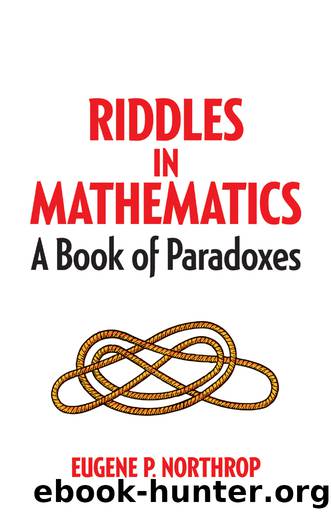Riddles in Mathematics by Eugene P Northrop

Author:Eugene P Northrop
Language: eng
Format: epub
Publisher: Dover Publications
Published: 2014-04-15T04:00:00+00:00
FIG. 77
The hopeful geometer of 1834 set up the figure of diagram (b) to aid him in his proof. Through B he drew B Y parallel to CD, and constructed angles ABN, NBO, OBP, and PBQ each equal to angle YBA, He correctly argued that whatever the size of angle YBA, he could, by constructing enough angles ABN, NBO, . . . , finally arrive at one whose side (BQ in the figure) falls below the line BZ, Suppose there are n – 1 such angles (there are four in the figure). He then marked off n – 1 segments, CE, EG, GJ, . . . , each equal to BC, and through the points of division drew lines EF, GH, JK, . . . , each parallel to CD, So far so good. But at this point he began to compare infinite areas. He maintained, for example, that the infinite area bounded on two sides by the infinite lines BY and BA is equal to the infinite area bounded on two sides by BA and BN, and that the infinite area bounded on three sides by the line segment BC and the infinite lines B Y and CD is equal to the infinite area bounded on three sides by the line segment CE and the infinite lines CD and EF. Or, as he put it, the area YBA is equal to the area ABN, and the area YBCD is equal to the area DCEF.
Let us assume for the moment that this argument and similar arguments about infinite areas are valid. The rest of the proof then runs: Area YBLM is equal to n times area YBCD, and area YBQ is equal to n times area YBA. But area YBLM is only a part of area YBZ, while area YBZ is in turn only a part of area YBQ. Hence n times area YBCD is less than area YBZ, which in turn is less than n times area YBA. That is to say, n-(YBCD) is less than n-(YBA), or YBCD is less than YBA. But if such is the case, AB must meet CD. For if AB did not meet CD, then YBCD would be equal to the sum of YBA and ABCD, and so would be greater than YBA.
The catch in this innocent-looking proof lies, of course, in the fact that the areas involved are infinite. Of two finite areas, we can say that the first is less than, equal to, or greater than the second. But two infinite areas cannot be compared—we can say only that they are infinite.
* * *
The remainder of this section will be devoted for the most part to “limiting curves”—curves which are defined as the limit of an infinite sequence of polygons, that is, of an infinite sequence of figures made up of straight lines. The notion of a limiting curve is not new to any of us who have studied plane geometry. Let us recall briefly how as familiar a curve as the circle can be regarded as the limit of an infinite sequence of regular polygons.
Download
This site does not store any files on its server. We only index and link to content provided by other sites. Please contact the content providers to delete copyright contents if any and email us, we'll remove relevant links or contents immediately.
Modelling of Convective Heat and Mass Transfer in Rotating Flows by Igor V. Shevchuk(6391)
Weapons of Math Destruction by Cathy O'Neil(6140)
Factfulness: Ten Reasons We're Wrong About the World – and Why Things Are Better Than You Think by Hans Rosling(4692)
Descartes' Error by Antonio Damasio(3229)
A Mind For Numbers: How to Excel at Math and Science (Even If You Flunked Algebra) by Barbara Oakley(3217)
Factfulness_Ten Reasons We're Wrong About the World_and Why Things Are Better Than You Think by Hans Rosling(3197)
TCP IP by Todd Lammle(3132)
Fooled by Randomness: The Hidden Role of Chance in Life and in the Markets by Nassim Nicholas Taleb(3043)
Applied Predictive Modeling by Max Kuhn & Kjell Johnson(3018)
The Tyranny of Metrics by Jerry Z. Muller(3000)
The Book of Numbers by Peter Bentley(2908)
The Great Unknown by Marcus du Sautoy(2645)
Once Upon an Algorithm by Martin Erwig(2598)
Easy Algebra Step-by-Step by Sandra Luna McCune(2578)
Lady Luck by Kristen Ashley(2530)
Practical Guide To Principal Component Methods in R (Multivariate Analysis Book 2) by Alboukadel Kassambara(2497)
Police Exams Prep 2018-2019 by Kaplan Test Prep(2482)
All Things Reconsidered by Bill Thompson III(2355)
Linear Time-Invariant Systems, Behaviors and Modules by Ulrich Oberst & Martin Scheicher & Ingrid Scheicher(2332)
